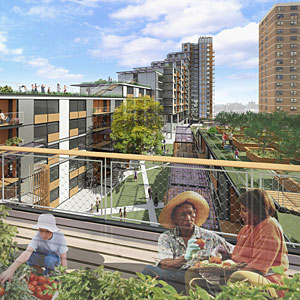Philadelphia, with the nation’s largest concentration of health care resources within a 100-mile radius—including America’s first hospital, founded in 1751 by Benjamin Franklin—has long provided a vigorous market for architects working in the health-care sector.

But in the past year, Mark Hebden, executive vice president of EwingCole, a local architecture and engineering firm, has watched as these types of projects have dried up due to a lack of funding. “Health care and academic institutions are seeing their endowments fall,” he says, “and thus the ratio of debt they can take on for building projects is falling as well.”
In recent months, he’s shifted his focus to government buildings, a sector that is showing signs of life due in part to the American Recovery and Reinvestment Act (ARRA). The U.S. General Services Administration alone received $5.5 billion in federal stimulus dollars to upgrade federal buildings and make them more environmentally friendly. “And this in particular impacts the Northeast, and Washington, D.C.,” Hebden says, citing the large number of older government buildings in the Northeast corridor.
The ARRA money is a vital shot in the arm for a region that has been hit hard by the recession. Architects in the Northeast, the wealthiest region in the United States, report that conditions are just as bad here as other areas of the country, and in some cases, worse: In December and January, the Northeast had the lowest scores on the Architectural Billings Index (31.9 and 32.1, respectively). The index, produced by the American Institute of Architects, is a key measure of the market for architectural services. A score above 50 indicates an increase in billings and below 50, a decrease.
“The North is kind of like everywhere else, which is pretty pathetic," says Kermit Baker, the AIA’s chief economist. While the Northeast’s ABI score has been rising in recent months, it has not climbed above 50 since January 2008. “Until the last few months we never had seen numbers in the 30s," says Baker, based in Boston. "The numbers were in the 40s for most of 2008, and in the 50s in 2007.”
Despite these bleak figures, some architects in the Northeast report there is still activity. “Numbers can be indicative of trends, yes, but they also hide things," says Rick Bell, executive director of the AIA's New York chapter. “Just walking the streets of New York, my sense is that certain types of housing, in particularly luxury housing, have been strong.”
He also notes affordable housing as a potential linchpin of recovery, citing both local and federal stimulus legislation. He knows of one project set to begin construction this summer: Via Verde, a multifamily project in the South Bronx designed by Grimshaw Architects and Dattner Architects, a New York firm. The project is the result of a design competition sponsored by his chapter. Bell says he views this project “as a replicable example, combining design excellence and affordability, that I'd like to think is immune from the downturn.” But, he adds, “In general, the situation is not good. We're seeing a downturn that is more extreme than in the past."
Those architects most severely impacted by the recession may find that smaller projects are a godsend these days. Billie Tsien, of the New York-based firm Tod Williams Billie Tsien Architects, says interior design is holding up decently in the Northeast because “people are choosing to improve what they have rather than start from scratch. It’s a normal part of one's practice when you're starting out—kitchens, bathrooms, lofts, etcetera—but also a part of practice that can mean survival in times that are not so great.” Tsien also notes that institutional projects that already had funding in place have been a mainstay of her firm’s practice, somewhat isolating it from the economic downturn. “That’s the most important thing—work that’s not market-driven," she says.
Construction for universities and pharmaceutical companies has slowed dramatically, but the combination of the two—funded by federal stimulus money—could represent a source of business for firms. The National Institutes of Health is receiving $1 billion in ARRA funds to support research at universities, all of which will go toward facility upgrades or construction. The funds should particularly benefit the Northeast, says Scott Butler, the director of the science and technology program at HDR CUH2A, based in Princeton, New Jersey. Since the money is allocated on a “on a pro-rata basis based on population, as well as who has the strongest research facilities,” he says, “the Northeast should get a significant portion of those funds.”


Post a comment to this article
Report Abusive Comment